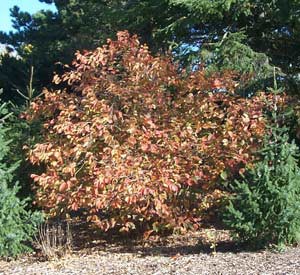Hazelnut – Pruning, Winter Care and Fertilizing

Fall color
Hazelnut or American Filbert
These shrubs should be pruned after they have bloomed. Shape and thin as needed, but keep in mind that you are removing this years nuts.
As the plant matures, renewal pruning will be needed. This is done in early spring, by removing the largest, heaviest canes all the way to the ground. One to five branches can be removed each year, depending on the size of the plant. If a reduction in the plants overall height is needed, it should be done in combination with renewal pruning.
By fertilizing young shrubs you can increase both the size and the amount of flowers on the plant. Granular, liquid or stake type fertilizers can be used. Granular types should be worked into the soil around the plant at a rate of 2 pounds or 2 pints per 100 square feet of planting bed. An alternative way is to drill or punch 6″ deep holes at the drip line of the plant. Poured into these holes should be a total of 1/4 pound of fertilizer per foot of height or spread of the shrub (divided up and poured evenly between all of the holes). These holes should not be filled with more than 1/3 of the fertilizer and then they should be top filled with soil. This method of fertilization should only be done once a year, and is best done in late fall after leaf drop, or in early spring before bud break. Liquid fertilizers (such as Miracle Gro) are mixed with water and applied the same as you would water the plant (see product for specific details). This should be done three or four times per year starting in late April and ending in mid July. Stake type fertilizers can be used following the directions on the package. With any of the above techniques a balanced mix should be used, 20-20-20 or 20-30-20 or 18-24-16. Organic fertilizers, like manure, can also be used with good results. The material should be worked into open soil at a rate of one bushel per one 6′ shrub or 100 sq. ft. of bed area.
These shrubs need little winter care but, should be occasionally checked for rabbit or other damage. If rabbit damage is found you can protect the plant with a fence formed with hardware cloth (looks like chicken wire but with small square holes). The branches of the plant should be tied in towards the center, then a circle of hardware cloth can be placed around the outside. The base of the hardware cloth should be buried in the soil or mulch. This protection should be installed in late November and removed in mid April.
